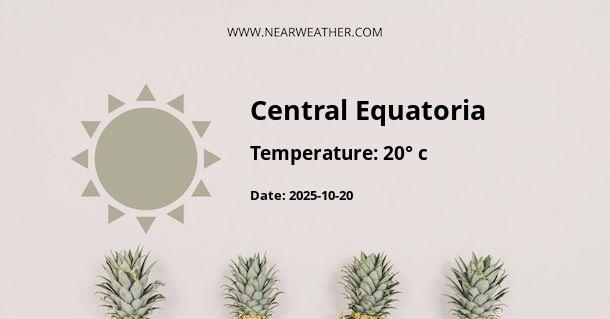Climate and Weather in Central Equatoria State, South Sudan
Central Equatoria State is located in the southern part of South Sudan and is known for its diverse climate and weather conditions throughout the year. The state experiences a tropical wet and dry climate, characterized by distinct wet and dry seasons. Understanding the climate patterns can help residents and visitors prepare for the weather conditions they may encounter in Central Equatoria State.
Temperature
The temperature in Central Equatoria State remains relatively high throughout the year due to its proximity to the equator. The average annual temperature ranges between 25°C (77°F) and 30°C (86°F). The hottest months are February and March, with temperatures often exceeding 35°C (95°F). Even during the cooler months, temperatures rarely drop below 20°C (68°F).
It is important to note that temperatures can vary depending on the elevation. In higher elevated areas such as the Imatong Mountains, temperatures tend to be cooler compared to the lowland areas.
Rainfall
Central Equatoria State experiences a distinct wet and dry season. The wet season typically lasts from April to October, with the peak rainfall occurring between May and September. During this period, the state receives an average annual rainfall of around 1,200 to 1,500 millimeters (47 to 59 inches).
The dry season, on the other hand, extends from November to March, with January and February being the driest months. During this time, rainfall is scarce, and the state receives only around 10 to 20 millimeters (0.4 to 0.8 inches) of precipitation on average.
The rainfall patterns in Central Equatoria State are influenced by the Inter-Tropical Convergence Zone (ITCZ), which shifts north and south of the equator throughout the year. This movement of the ITCZ brings the wet and dry seasons to the region.
Humidity
Central Equatoria State experiences high levels of humidity throughout the year. The humidity is influenced by the proximity to the Nile River and the presence of dense vegetation. During the wet season, humidity levels can be particularly high, reaching 80% or more. The combination of high temperatures and humidity can make the weather feel even hotter and more uncomfortable.
Wind Patterns
The wind patterns in Central Equatoria State are generally influenced by the seasonal shifts in the ITCZ. During the wet season, the prevailing winds blow from the south and southeast, bringing moisture from the Indian Ocean. These winds can sometimes be accompanied by thunderstorms and heavy rainfall.
In contrast, during the dry season, the prevailing winds blow from the north and northeast, bringing drier air from the Sahara Desert. These winds are typically weaker and contribute to the dry and dusty conditions during this time.
Extreme Weather Events
Central Equatoria State is prone to certain extreme weather events, including thunderstorms, heavy rainfall, and occasional flooding during the wet season. These events can lead to localized damage and disruptions to transportation and infrastructure.
It is important to stay informed about weather forecasts and take necessary precautions during times of extreme weather to ensure personal safety and minimize any potential risks.
Climatic Regions within Central Equatoria State
Central Equatoria State can be further divided into two distinct climatic regions:
-
Lowland Areas
The lowland areas, including Juba and its surroundings, experience a hot and humid climate. These areas receive a higher amount of rainfall compared to the higher elevated regions. The vegetation in these areas is typically characterized by savannah grasslands and scattered trees.
-
Highland Areas
The highland areas, such as the Imatong Mountains, have a cooler and more temperate climate due to the higher elevation. These areas receive slightly lower amounts of rainfall compared to the lowland areas. The vegetation in these regions is characterized by forests and montane grasslands.
Conclusion
Central Equatoria State in South Sudan experiences a tropical wet and dry climate, with distinct wet and dry seasons. The temperature remains high throughout the year, with the hottest months being February and March. The wet season, from April to October, brings heavy rainfall, while the dry season, from November to March, experiences minimal precipitation. The state is also prone to extreme weather events such as thunderstorms and occasional flooding. Understanding the climate patterns can help residents and visitors prepare for the weather conditions and make informed decisions accordingly.
A - Central Equatoria's Latitude is 4.750000 & Longitude is 31.000000.
A - Weather in Central Equatoria is 23° today.
A - Climate Conditions in Central Equatoria shows scattered clouds today.
A - Humidity in Central Equatoria is 56% today.
A - Wind speed in Central Equatoria is 1.91 km/h, flowing at 14° wind direction. today.
